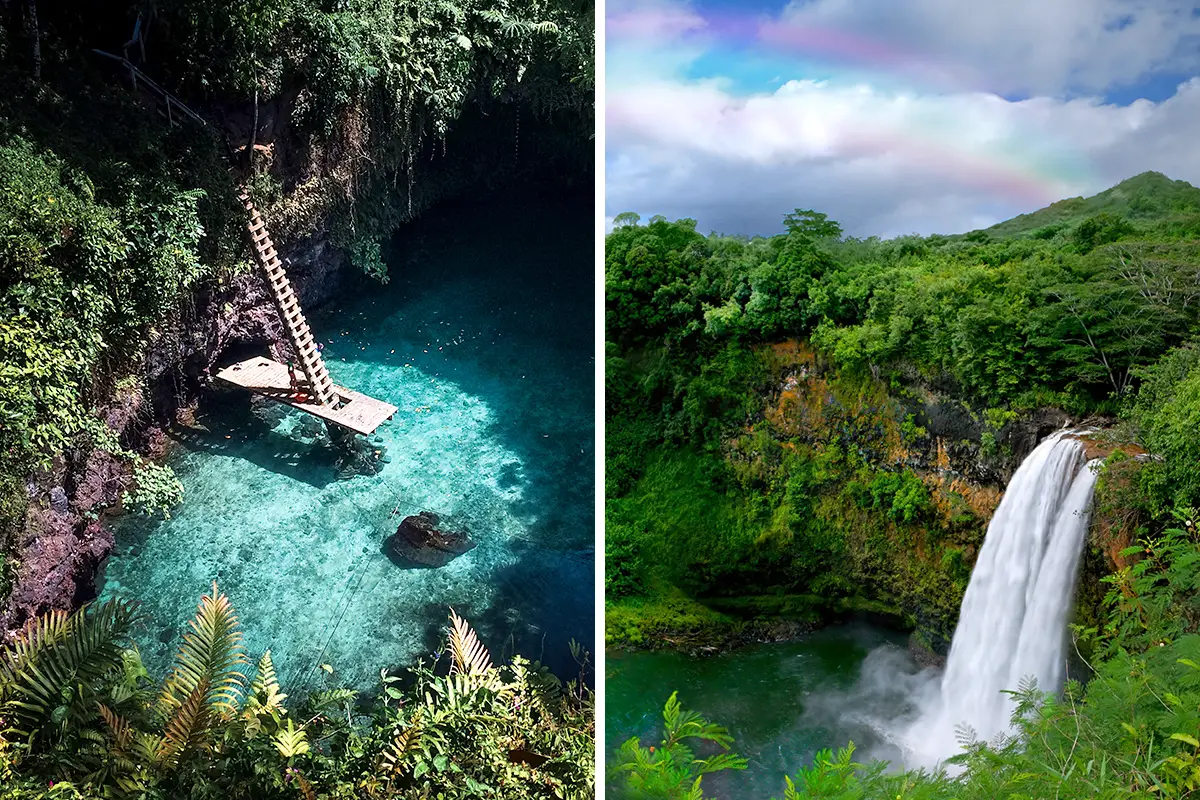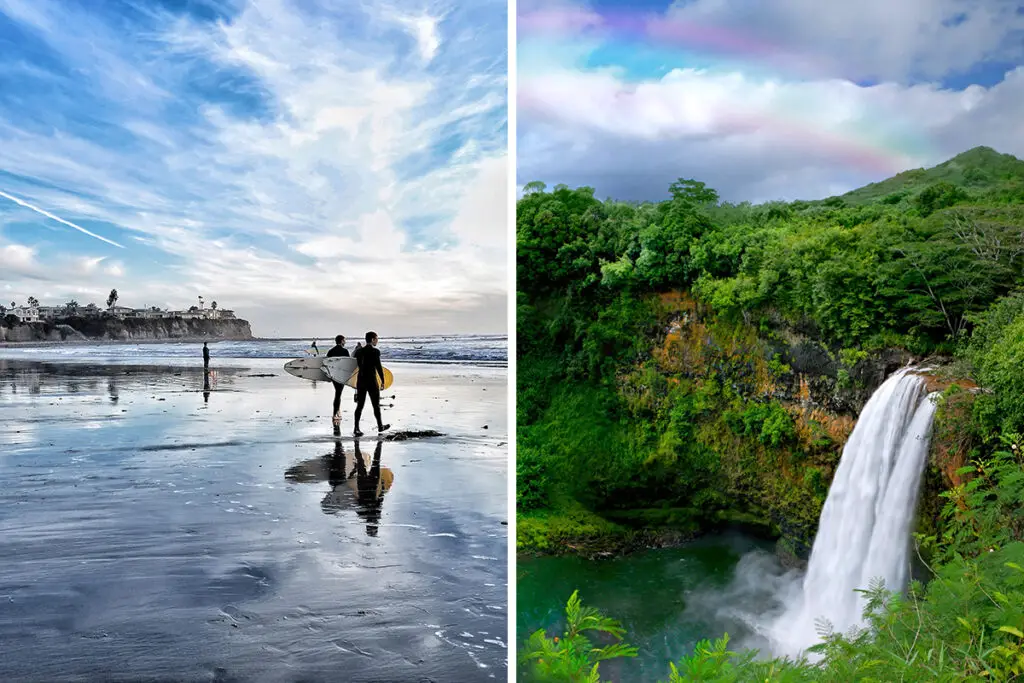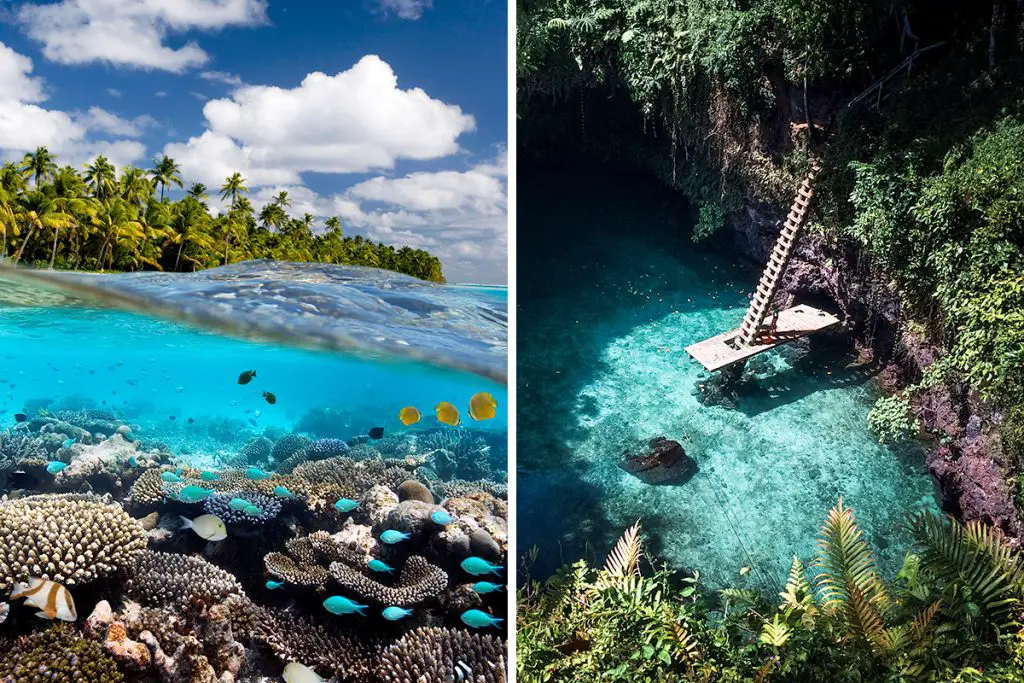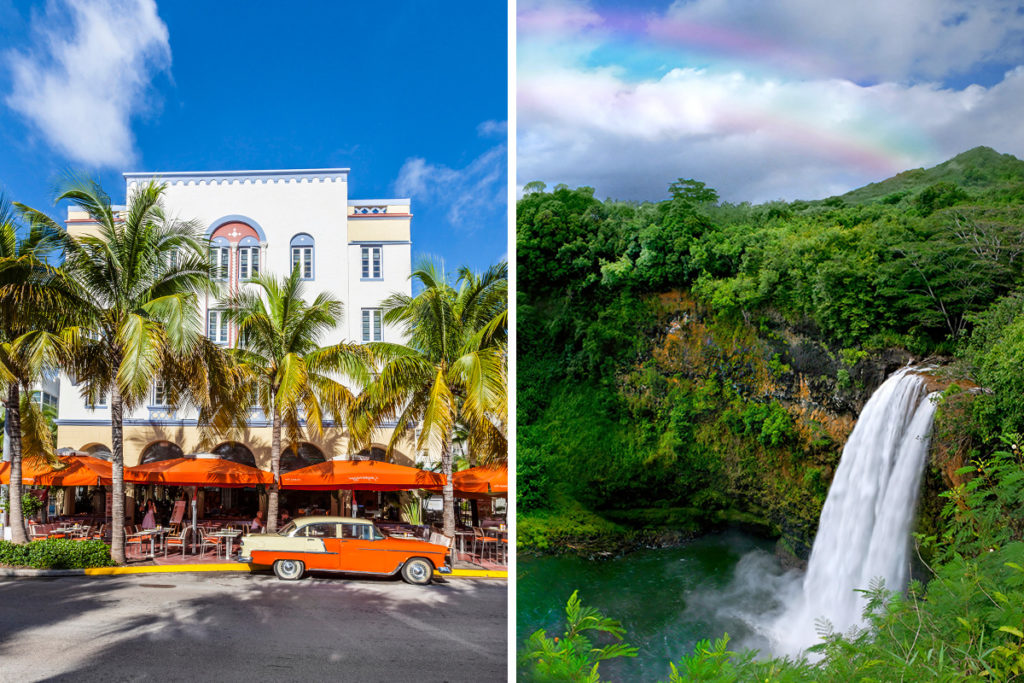If you love water activities, then Hawaii is your place. The islands are home to some of the most beautiful beaches in the world and are also known for their welcoming locals and rich Hawaiian culture. They offer boat tours that allow tourists to see some of their most famous landmarks, including Waikiki Beach, Diamond Head, and Pearl Harbor.
While the islands are well known for their beaches, there is much more to them than sand and palm trees. Hawaii also has historical sites, museums, and diverse landscapes for you to visit.
Similarly, there are many things to do in Samoa, including snorkeling, scuba diving, hiking, and cultural excursions. Besides the water activities, the country has many landscapes to explore.
Samoa also has several museums, including Falemata’aga, the National Museum of Samoa, which houses archaeological items from their ancestors. Samoa also has The Robert Louis Stevenson Museum, home of the late author known for his works like Treasure Island and Strange Case of Dr. Jekyll.
Samoa
Samoa is a Polynesian island nation in Oceania. The country consists of nine islands; most of the population lives on four islands, while the others aren’t occupied. The islands have a lot to offer their visitors, and the Samoan culture and cuisine are one of the most exciting and unique in the world.
The landscape is diverse, with beautiful beaches and blowholes on Savai’i Island, rugged volcanic mountains on Upolu Island, lush forests on Tutuila Island, and more.
Samoa has an incredible culture. The Samoan people have lived on this island for thousands of years and developed a way of life reflecting their rich cultural heritage. The people of Samoa have a deep sense of spirituality and connection to their land and the sea. The Samoan culture comprises many elements, including religion, language, music, and dance.
What Makes Samoa Unique
Diverse Landscapes
The country is famous for its warm, clear waters and white-sand beaches, including secluded coves perfect for snorkeling and scuba diving.
Besides the standard vacation landscapes, Samoa has diverse landscapes like the Alofaaga Blowholes and the To Sua Ocean Trench, offering many activities for visitors that they’ll only find in Samoa. National parks have trails for hiking and mountain biking, and these trails have gorgeous views of the islands, surrounded by lush rainforests and local fauna. Samoa has plenty of activities that can keep you busy for days.
Lefaga Beach
The picturesque beach is on the island of Upolu. Lefaga Beach was in the 1953 film “Return to Paradise” starring Gary Cooper. If you’ve seen the film, you’ll recognize some of its landscapes. The beach has impressive lagoons and giant clams and is famous for them. It’s also the best choice for snorkeling, swimming, and sunbathing in Samoa.
Aganoa Beach
If you’re adventurous and up for a challenge, Aganoa beach is for you. The beach is on the east coast of Savai’i island and held the South Pacific Games in 2007, making it a perfect spot for experienced surfers. Athletes love the challenge, but visitors must be careful since the currents are unpredictable.
To Sua Ocean Trench
Located on Upolu Island, To Sua translates to ‘Giant Swimming Hole.’ The water hole formed when a lava tube system caved in, and erosion over the years shaped the trench into the tourist attraction it is today. There’s a ladder for visitors who want to take it slow, but if you’re tempted to dive head first, you can jump into the hole during high tide.
There are things to be mindful of when swimming in the trench—
Don’t wear revealing clothing to respect the locals. Be careful when using drones in the area since poor reception might affect the drone. The entrance fee for To Sua Ocean Trench costs 20 WST (8 USD) per adult and 10 WST (5 USD) for children.
Alofaaga Blowholes
The Alofaaga blowholes are on the Savai’i island of Samoa near Taga village. Over time, lava forms blowholes in underground caves and sometimes sprays water into the air.
Water spouts happen when waves from the ocean crash against the rocks, pushing air through cracks in the rock and causing pressure to build. Although dangerous, you can play around the blowholes by putting coconuts inside the vents before they blow to launch them in the air.
It’s advised to visit the blowholes during high tide to enjoy it. The entrance fee to the natural wonder is 5 to 10 WST (2 to 4 USD), which requires another payment for the parking fee.
Preserved Wildlife
Besides the country’s beautiful landscapes, Samoa managed to preserve its fauna and flora with the help of its national parks. There are several national parks in Samoa, each with unique features that make them special.
Locals and organizations like the Ramsar Convention preserved Samoa, making it a paradise for nature lovers. If you want to explore untouched beauty and wildlife, then Samoa is for you.
Lake Lanoto’o National Park
Lake Lanoto’o National Park is home to several endangered species, like the Manumea (Tooth-billed pigeon) and the Mao. Besides endangered species, you can find the common house pet, the Goldfish, in the wild here.
The lake is under the wetlands of international importance under the Ramsar Convention in Samoa. The park is also known for its beautiful waterfalls, which are the perfect backdrop for some stunning pictures.
O Le Pupu-Puʿe National Park
O Le Pupu-Puʿe National Park is the oldest national park in Samoa and began in 1978. It’s the last registered wetland in Samoa under the Ramsar Convention due to its sustenance to the locals around it.
Tour guides will teach you how volcanic activities shaped Samoa’s landscapes; a perfect example would be the O le Pupu-Pue Lava Cliffs. These cliffs are giant isolated islands; they’re a marvel to look at when the enormous waves pelt them.
Culturally Rich Museums
Samoa has stunning views, but it isn’t only about landscapes. The country is rich in culture and features museums like the Jean P. Haydon Museum, which displays the artifacts of how the early Samoans used to live.
Samoa also houses the Robert Louis Stevenson Museum, a dedicated museum for the late writer of the novels Treasure Island and Strange Case of Dr. Jekyll and Mr. Hyde.
Falemata’aga is Samoa’s national museum and is still developing since it is still improving its collection.
Jean P. Haydon Museum
The Jean P. Haydon Museum has artworks, artifacts, and textiles from the early Samoans, such as canoes and enu baskets. The museum aims to preserve the culture of Samoa with its collection.
Besides local artifacts, the museum has moon rocks and exhibits commemorating their help in the US Apollo mission. The late president Richard Nixon gave the moon rocks as a gift after the Apollo mission ended.
Robert Louis Stevenson Museum
If you’ve read Strange Case of Dr. Jekyll and Mr. Hyde or watched the Disney movie Treasure Planet, a science-fiction adaptation of Robert Louis Stevenson’s Treasure Island, you’ll love this museum. The author spent the last few years of his life in Samoa and fell in love with the country, and the locals regard him as a man with great ‘mana.’ The structure was the house of the late author, which later became a museum that contained his belongings.
Falemata’aga
Falemata’aga is inside the oldest building in Apia, which used to be a school. Falemata’aga is Samoa’s national museum and still functions like a school.
They hold exhibits to showcase their collection since the museum’s goal is to spread the heritage and culture of Samoa. The museum has gathered many artifacts, and its collection continues to grow. It’s a great place to visit if you want to learn more about Samoa’s heritage and culture.
Polynesian Delicacies
Samoa has a lot of local delicacies that you’ll only find in Polynesia. Meat and chicken are the ingredients used in cooking, but coconut is the most used ingredient in Samoa. One of the most famous Samoan dishes is Palusami, made with taro and coconut milk wrapped in leaves and steamed. If you’re searching for exotic food, try the raw octopus salad or tuna sashimi.
Palusami
Palusami is a famous Samoan dish with corned beef, taro leaves, and coconut milk. It’s best served when cooked in an earth oven, which can be found across Samoa. Palusami is usually served as an appetizer or a main course if served with rice.
Talo Lolo’i
Talo Lolo’i is another popular dessert in Samoa, made from cubed taro roots and boiled in water until they become soft. After softening the taro, add sugar, salt, and coconut milk. Taro root looks like potatoes but tastes different. Taro contains starch, making it sweet and fluffy when raw or boiled.
Sapasui
Sapasui, or Samoan chop suey, is a traditional dish made with vermicelli. It is usually served with meat, beef, chicken, pork, and soy sauce. This recipe calls for chicken or beef, but you could make it vegetarian by eliminating the meat and adding more vegetables.
This dish has Chinese origins and is often served at parties, weddings, and special occasions. It may vary in recipes depending on the region where it’s served.
Hawaii
When you think of Hawaii, it’s easy to understand that you’d imagine a tropical vacation on the beach. But Hawaii is more than beaches and palm trees — there are also volcanoes to hike, valleys to explore, and even world heritage sites to visit. Many tourist attractions in Hawaii draw in thousands of tourists, like Pearl Harbor National Memorial, Diamond Head State Monument, and the Polynesian Cultural Center.
It’s a state filled with incredible natural beauty, exciting culture, and delicious food. There’s a lot to do while on vacation in Hawaii besides relaxing on the beach all day.
What Makes Hawaii Unique
Frozen-In-Time Locations
Many locations here will make you feel like time froze in Hawaii. If you’ve seen the 1993 film Jurassic Park, sites like the Nā Pali Coast and Allerton Garden will remind you how captivating the scenes were, as some scenes feature these locations. Sites like Pearl Harbor National Memorial, USS Utah Memorial, and USS Oklahoma Memorial have artifacts that will remind you of the sacrifices made in the past for what we have today.
Nā Pali Coast State Wilderness Park
The Nā Pali Coast State Wilderness Park exists to protect the Kalalau Valley. The rough translation of Nā Pali in Hawaii means “the cliffs” or “many cliffs”; hence the area’s name. Nā Pali rises around 4,000 feet (1,200 m). The cliffs are in the film Jurrasic Park and have excellent views from the ocean and above.
You can hike the cliffs and camp in the area with a valid camping permit. Before camping, there’s much time to consider since applying for camping permits is up to 90 days in advance. You can reserve camping permits through their website, where you can also find the rules.
Allerton Garden
Allerton Garden is a collection of unique plants in Hawaii, like the Corypha and the Raphia palm, and the garden also holds art exhibits in the area. One of the featured attractions in the garden is the towering Moreton Bay fig trees, which are in films like Pirates of the Caribbean and Jurassic Park.
Allerton Garden has many tour packages that vary in duration and amenities. The price of the tours ranges from 60 to 175 USD per adult and 30 to 150 USD for children.
World War II Memorials in Hawaii
Hawaii has many memorials commemorating the brave acts committed for freedom during World War II. Pearl Harbor National Memorial has sites like the USS Arizona Memorial, USS Utah Memorial, and USS Oklahoma Memorial.
Entering USS Oklahoma and USS Utah Memorials has requirements and needs reservations, but you can visit Pearl Harbor National Memorial, roam the grounds, and visit the museums.
There are many things to do at Pearl Harbor National Memorial, and they also have programs that will educate you, but it’s advised to check their website for their rules and reservations.
Exciting Parks
Hawaii has a variety of parks offering many activities and adventures that will keep you busy during your visit. The diverse landscape of the islands of Hawaii allows them to have different kinds of parks, making it a unique vacation destination. Some of their famous parks include Haleakalā National Park and Waimea Canyon State Park.
Haleakalā National Park
Haleakalā is on the island of Maui. In the Hawaiian dialect, Haleakalā translates to “House of The Sun.” According to Hawaiian legends, the frustrated demigod Maui drew in the sun to make the day last longer, hence the name, House of The Sun.
Haleakalā is the closest you’ll ever get to being on Mars since it has vast lunar-like landscapes. The national park is safe to explore since the volcano is already dormant. The other areas of Haleakalā have subtropical rainforests, home to endangered species like the Maui Parrotbill, Crested Honeycreeper, and Scarlet Honeycreeper.
You can do many things in Haleakalā, such as camping, hiking, and stargazing, but the most popular thing to do in Haleakalā is watching the sunrise on Pu’u‘ula‘ula. It’s best to plan if you want to visit Haleakalā since some activities need reservations on their website.
Waimea Canyon State Park
Waimea in Hawaiian translates to “reddish water,” referencing the red eroded soil of the canyon. It’s easy to see why Waimea Canyon State Park is the Grand Canyon of the Pacific. You can go on helicopter and biking tours to see the different angles of the canyon’s beauty. If you want to explore the canyon at your own pace, there are hiking trails and lookouts for you to take.
The entrance fee costs 5 USD for adults and is free for children under 3. Parking fees cost 10 USD per vehicle and may differ for commercial vehicles. Rules and regulations of the park are on their website.
Hawaii’s Famous Beaches
It’s understandable if you associate Hawaii with palm trees and long stretches of beaches, but each Hawaiian beach is unique and special. Whether you’re looking for a quiet place to relax or an adventurous location with endless activities, Hawaii’s beaches provide many things to do. Hawaii’s famous beaches include Waikiki Beach, Punalu’u Beach, and Hapuna State Beach.
Waikiki Beach
Waikiki Beach is Hawaii’s biggest tourist attraction, known for its white sand, gentle waves, and scenic view of the Diamond Head State Monument. It’s a popular tourist destination for visitors worldwide and is often considered one of the most beautiful beaches in the United States.
The waves are so calm that they held the first FINA World Open Water Swimming Championships here. You can also see the statue of Duke Kahanamoku, Olympic Champion and Father of Modern Surfing. Duke Kahanamoku was a hero and saved eight people from drowning with his surfboard. If you love water activities, then Waikiki beach is your place.
Hāpuna Beach
Hāpuna Beach is the largest white-sand beach on Big Island. The beach is like a park merged with the ocean; families can relax and take picnics. There are many amenities nearby for visitors to enjoy.
Experienced or not, you can practice snorkeling, kayaking, and surfing since the waves are calm. It’s also accessible, and there are always lifeguards, so there’s no need to worry while relaxing.
Punalu’u Beach
Volcanic activities create black-sand beaches, creating many in Hawaii. Punalu’u Beach is the most famous among the black-sand beaches for its green sea turtles. If you want to take a break from water activities and relax on the beach while having a picnic, then Punalu’u Beach is perfect for you. The warmth of the beach while watching sea turtles is an incomparable feeling for relaxation with the family.
It’s advisable to bring proper footwear as the black sand absorbs heat and may be hotter than a usual beach. The beach’s waters are intense and unpredictable, so it’s best to ask the lifeguards if it’s allowed to swim.
Hawaii’s Heritage
There’s no better way to learn about Hawaii’s diverse and exciting culture than by exploring its many sights and learning the stories about them from your local guide.
Hawaii’s mythology plays a vital role in its culture and is one of the essential factors in Hawaiian life. The mythology of Hawaii explains the island’s culture, why they observe traditions, and how people should behave.
Like ancient Greece, Hawaiians have many Gods that excel in certain aspects. Hawaiian mythology tells us about the origins of the Hawaiian people and their values, beliefs, and traditions. The stories that form Hawaii’s mythology are also an essential part of its literature, which includes songs, legends, and myths.
An example of how Gods affect Hawaiians is how they worship Lono, the god of peace, wisdom, enlightenment, fertility, and harvest. Hawaiians annually celebrate the Makahiki festival from October to February to honor Lono. Fly on over on this period if you’re interested in immersing in the culture through their celebration.
Which Is Better – Samoa or Hawaii?
Samoa and Hawaii are similar but have different things to offer. Depending on what you’re looking for, you’ll decide which is better.
Samoa is a beautiful island nation with blue waters, white-sand beaches, and lush volcanic landscapes. It’s also home to some of the friendliest people in the world, which makes it an ideal destination for those looking for a relaxing holiday. Samoa is a backpacker’s paradise, with a relaxed atmosphere, beautiful beaches, and plenty of budget hotels.
While Hawaii is home to some of the most beautiful beaches in the world, they have black or white sand and clear water, perfect for swimming or surfing. Hawaii also has great volcanos, canyons, and valleys, offering great views to visitors. There’s also a lot to learn about Hawaii’s exciting culture. If you are looking for a place where the mountains meet the sea, then Hawaii is perfect.
FAQ
Samoa vs. Hawaii Culture
The cultures of Samoa and Hawaii are similar but different since they are formed by people from various parts of the world. They are identical in culture since they are from the same geographical region. Both are devoted to their religion and have high regard for their elders.
The people of Samoa and Hawaii are amicable and welcoming to visitors. They love to share their culture with others and are proud of it.
Is Samoa Part of Hawaii?
Samoa is not a part of Hawaii, but both countries are part of Polynesia. Samoa is a nation in the South Pacific Ocean, while Hawaii is an archipelago of islands under the United States.
American Samoa and Samoa are neighbors, but Samoa isn’t under the United States.
Is Samoa Close to Hawaii?
Samoa is not close to Hawaii, but they aren’t far from each other. They are only a few hours and miles apart in the same geographical region.
Where Is Samoa Located in Relation to Hawaii?
Hawaii is in the northern Pacific Ocean, and Samoa is in the south-central Pacific Ocean. The islands are part of Polynesia, a subregion of Oceania.
How Far Is Samoa From Hawaii?
Samoa is 2,583.47 miles (4,157.69 km) away from Hawaii. They’re only a few hours apart, making it easy to transfer from Samoa to Hawaii or vice versa.
Which Is Bigger – Samoa or Hawaii?
Hawaii is larger than Samoa. Samoa is 2,842 km² (1,097 sq mi), and Hawaii is 10,931 sq mi (28,311 km²). Both locations are an archipelago of islands, but Hawaii has a larger territory.
How Do I Get From Samoa to Hawaii?
The best way you can get from Samoa to Hawaii is by plane. You can also try sailing, but you’ll need your ship since the only vessels connecting the two are cruise ships. If you plan to sail on your own, you must contact the harbor manager before entering the premises.
Can You Fly From Samoa to Hawaii?
Flights from Samoa to Hawaii are under Hawaiian Airlines, Southern Airways Express, and Fiji Airways. Ticket prices cost around 350 to 1,400 USD. It’s best to check travel agencies for better package prices.
Hawaii to Samoa Flight
Flying from Hawaii to Samoa is the best way to travel between the two locations. It’s the fastest and most affordable way to travel between the two. You’ll also have a great view of the archipelago of islands. It’s best to take note of the island you’re on to lessen the stopovers.
Hawaii to Samoa Flight Time
The flight from Hawaii to Samoa takes 5 to 6 hours and 30 minutes. Depending on the airline and itinerary may be quicker. Booking in certain airports may lead to layovers.
How Much Is a Flight From Hawaii to Samoa?
A roundtrip flight from Hawaii to Samoa costs around 1,300 USD, depending on what airline and seats you want to book.
How Far Is Samoa From Hawaii on a Boat?
Samoa is 2,244.97 nautical miles away from Hawaii.
How Long Does It Take to Sail From Hawaii to Samoa?
Depending on how fast you’re traveling, it may take 7 to 26 days to sail from Samoa to Hawaii. Weather conditions may also prolong the trip.







